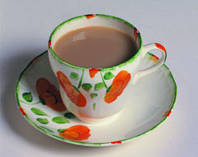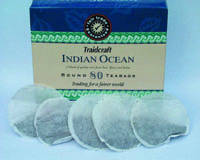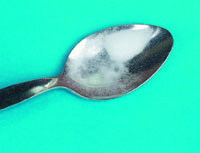 Tea (and coffee) contains all sorts of exotic compounds that give it its flavour and aroma. However, the main biologically active constituent of tea is one of the most widely used drugs there is: the stimulant caffeine. This is rather odd because it's a substance not found in many other plants.
Tea (and coffee) contains all sorts of exotic compounds that give it its flavour and aroma. However, the main biologically active constituent of tea is one of the most widely used drugs there is: the stimulant caffeine. This is rather odd because it's a substance not found in many other plants.
The tea that we drink is a hot-water infusion of the leafy shoots of the tea plant, Camellia sinensis, which have been processed in a variety of ways depending on the type of tea required. Most of us drink 'black tea', which is distinct from 'green tea' - what we call 'China tea'.
The leaves of the tea plant contain very large quantities of chemicals; as much as 30 per cent of the dry weight. Caffeine itself represents between one and four per cent of the dry weight of the leaves. Although, on a weight-for-weight basis, coffee beans contain only half this much caffeine, a cup of coffee contains about twice as much caffeine as a cup of tea - 100mg rather than 50mg - because the caffeine is more efficiently extracted from coffee than from tea.
This activity gives you an opportunity to isolate a fairly pure sample of caffeine from tea leaves. It’s amazing that you can obtain beautiful colourless caffeine crystals from something as unlikely as wet, dark-brown tea leaves. Because the caffeine content of dry tea leaves is so small, be prepared for your yield to be quite low though.
Sublimation
In this activity, you’ll use a particular property of caffeine to isolate it from the crude tea residue – its ability to sublime. As you heat most solids, they melt to give a liquid, which if heated further will (normally) vaporise to a gas. However, solid caffeine, when heated forms a vapour directly, without passing through a liquid phase. This process is called sublimation.
Caffeine sublimes at around 160° C and, when the caffeine vapour cools, it re-forms the pure solid. It’s therefore a very convenient way of separating it from impurities (which don’t sublime). Another compound that sublimes is carbon dioxide. Although it’s a gas at normal temperatures and pressures, solid carbon dioxide won’t pass through a liquid stage as it warms up at atmospheric pressure. This is why it’s sometimes called ‘dry ice’.
Decaffeinated coffee
Caffeine can be removed from coffee beans, before they’re roasted, by a process called solvent extraction. Water is first added to the beans to bring their moisture content up to about 40 per cent. The caffeine is then removed from the beans using a solvent called dichloromethane at temperatures between 50 and 120º C , and under pressure – conditions fairly selective for caffeine. Residual solvent and moisture are then driven off and the beans roasted.
Another solvent that’s also extremely selective for caffeine extraction is liquid carbon dioxide at high pressure, 120–180 atmospheres (despite what’s said above under ‘sublimation’, carbon dioxide does go through a liquid stage – but only at high pressures). This process has the advantages that it doesn’t remove the compounds that give rise to the flavour, and it means there’s no possibility of toxicity due to solvent residues.
Throughout this activity, bear in mind that caffeine is a toxic substance. The caffeine that you isolate is not to be consumed. Once extracted, keep your caffeine sample in a safe place, and out of the reach of children and animals.
 What you need:
What you need:
- Pyrex test tube (borrowed from a pharmacist or school)
- 5 tea bags
- water
- 2 small saucepans
- sodium carbonate (washing soda or soda crystals, 2 teaspoonsful)
- about 250cm3 of corn oil (1cm3 is the same as 1ml)
- plastic drinking straw
- wooden clothes peg
- small sealable plastic bag
- measuring jug
- wooden spoon
- 2 dessert spoons
- teaspoon
- paper tissues
What to do:
The first step is to produce a crude extract of tea from which impure caffeine can be isolated. For this, we need to choose an appropriate solvent. Given what you know about tea, what solvent do you think would be a suitable choice?
Since the drink is made by adding boiling water to tea leaves, water would seem to be the answer.
Boiling water is unlikely to extract only the caffeine though; other compounds will be extracted too. We’ll need to separate the caffeine from these other compounds at a later stage.
- In a small saucepan, boil 200cm3 (about 6 fl. oz) of water. To the boiled water add 5 tea bags. (You need about 20g of tea leaves, so check the packet to see exactly how many bags you need.) Continue to boil gently, occasionally stirring and prodding the bags with a wooden spoon. After 10 minutes, take the saucepan from the heat and carefully remove the tea bags, squeezing them between two dessert spoons as you do so.
Tea leaves contain lots of acidic components called tannins, from which we need to separate the caffeine, which is a neutral compound. We do this by converting these acidic components into non-volatile compounds by adding a base – in this case, sodium carbonate. - Add about 10g, or two tsp., of sodium carbonate to your aqueous tea extract. You should notice a distinct fizzing when you add the first of the sodium carbonate, as it reacts with the acidic tannins to release carbon dioxide gas. Simmer the solution for 5 minutes and then boil most of the water off.
Towards the end, you’ll need to heat the pan very gently so that the solution doesn’t spit hot liquid over you, and so that you don’t char the residue. You may find that loosely covering the pan with a lid allows the steam to evaporate while keeping the tea extract in the pan.
- When all of the water has been removed you should be left with a relatively dry, black-brown solid. Take the saucepan from the heat and let the residue cool. When it’s cool, transfer enough of it to fill the bottom of a clean, dry test tube to a depth of about 1cm.
- Now, pour corn oil into a small clean saucepan until it’s about half full. Using a wooden spring-loaded clothes peg, hold the test tube in the oil so that about 3cm of the tube is immersed. Heat the oil to about 250° C or slightly above (so that it would be hot enough to fry chips). If you don’t have a wooden clothes peg, then you could make wire tongs from the wire of a sparkling-wine cork holder.

Hold the test tube in a small pan of oil and heat.
As the residue in the test tube heats up, you should see traces of water vapour condense on the colder parts of the tube that are out of the oil. CAREFULLY insert a paper tissue into the tube and wipe around the inside of the glass to absorb the water, then remove the tissue. Eventually, you should see a colourless/white solid collecting on the walls of the test tube just above the level of the oil.
Keep the tube in the oil for about 15 minutes, then carefully remove it and put it somewhere safe to cool.
 5. Flatten a plastic straw at one end and, when the tube is cold, use it carefully to scrape out your pure sample of caffeine. Place your crystals in a small plastic bag (for safe keeping) and label the bag with the name of the substance.
5. Flatten a plastic straw at one end and, when the tube is cold, use it carefully to scrape out your pure sample of caffeine. Place your crystals in a small plastic bag (for safe keeping) and label the bag with the name of the substance.
Rate and Review
Rate this article
Review this article
Log into OpenLearn to leave reviews and join in the conversation.
Article reviews
In your experiment, per tea bag, what was your yielded caffeine weight? I attempted this as well (with a slight variation) and I am trying to figure out whether I did it correctly (and obtained viable results).
Hi,
If you follow the steps correctly and successfully isolate the caffeine, you’d expect roughly 2.2mg of caffeine; if you try the experiment with a single teabag, it’d be around 0.5mg – although, of course, the type of tea may cause variations.
Hope this helps.
Best wishes
OpenLearn Moderator